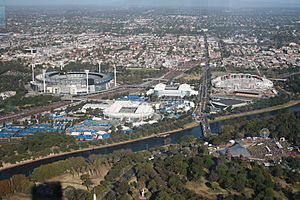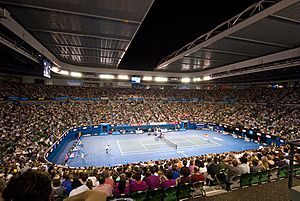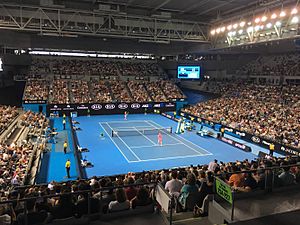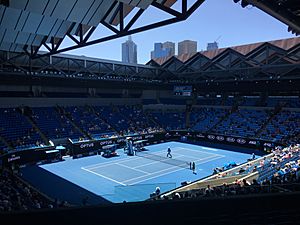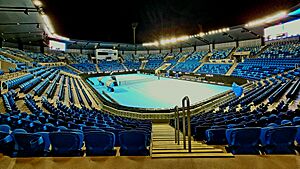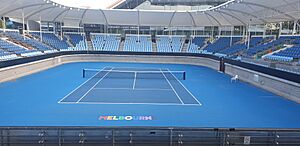Melbourne Park facts for kids
Melbourne Park is a famous sports place in Melbourne, Victoria, Australia. Since 1988, it has been the home of the Australian Open tennis tournament. This big event happens every January.
Melbourne Park has many courts where tennis matches are played. Rod Laver Arena is the biggest, holding 15,000 people. John Cain Arena can seat 10,500, and Margaret Court Arena holds 7,500. These three main arenas have roofs that can open or close. This means games can continue whether it's sunny or raining. There are also other courts like Show Court 3 and 1573 Arena, each seating 3,000. The new Kia Arena, opened in 2022, seats 5,000. In total, Melbourne Park has 35 outdoor tennis courts.
The Victorian Government owns Melbourne Park. The Melbourne & Olympic Parks Trust manages it. This trust also looks after the nearby Melbourne Rectangular Stadium.
Contents
History of Melbourne Park
The park was first called Flinders Park until 1996. Then, the premier of Victoria, Jeff Kennett, changed its name to Melbourne Park. He wanted to help advertise Melbourne to people all over the world during big events. Some people didn't like the change at first. But over time, the new name became well-known.
Melbourne Park was built in 1988 to host the Australian Open. The old place, Kooyong Lawn Tennis Club, was too small for the growing tournament. Building the park cost at least $94 million. Players and fans loved the new facilities. Many said they were the best of all the four Grand Slams. In 1996, more money was spent to add two larger show courts and eight new courts. A big grassy area, now called Grand Slam Oval, was also added.
Exciting Events at Melbourne Park
Melbourne Park is famous for tennis, but it hosts many other events too. It's a popular spot for big international music stars. This is because it has some of the largest venues in Melbourne.
Besides the Australian Open, which attracts over 800,000 people, other sports are played here. Netball teams like the Melbourne Vixens and Collingwood Magpies play home games at John Cain Arena and Margaret Court Arena. The National Basketball League team Melbourne United also plays at John Cain Arena. In the past, Melbourne Park has hosted ice skating, track cycling, swimming, and motorsport events.
In January 2025, the Australian Open featured pickleball for the first time. The AO Pickleball Slam tournament was held on Court 3. Top Australian pickleball players competed for $100,000 in prize money.
Arenas and Facilities
Melbourne Park is special because it's the only Grand Slam tennis venue with three courts that have retractable roofs. This means games can keep going even if it rains or if it's extremely hot.
Rod Laver Arena: The Main Stage
Rod Laver Arena is the biggest court, holding almost 15,000 fans. It has a roof that can close. It opened in 1988 and was first called the National Tennis Centre. In January 2000, it was named after Rod Laver, one of Australia's greatest tennis players.
Many amazing tennis matches have happened here, including:
- Rafael Nadal vs. Roger Federer (2009 & 2017 finals) – These two tennis legends played two finals here, both going to five sets. The 2009 final was famous for Federer's emotional reaction after the match.
- Novak Djokovic vs. Rafael Nadal (2012 final) – This match is one of the greatest ever. Djokovic won his third Australian Open title in a nearly six-hour battle. It was the longest Grand Slam final in history.
- Lleyton Hewitt vs. Roger Federer (2003 Davis Cup semi-final) – Hewitt made an incredible comeback to beat Federer. This win helped Australia reach the Davis Cup final.
John Cain Arena: The Energetic Court
John Cain Arena is the second-largest court, opened in 2000. It can hold 10,500 people and also has a retractable roof. It cost $65 million to build. This arena has hosted many different events. These include boxing matches, netball and basketball finals, and concerts by famous musicians.
During the Australian Open, John Cain Arena hosts many matches. It was the site of the longest women's singles match in a Grand Slam. Francesca Schiavone beat Svetlana Kuznetsova in a match that lasted four hours and forty-four minutes in 2011. Since 2015, fans with cheaper "ground passes" can enter this arena. This has made it a very lively place, especially when Australian players are on court.
Margaret Court Arena: Fast Roof and Debates
Margaret Court Arena opened in 1988. It was first called Show Court 1. After a renovation, its seating grew to 7,500. It also got a retractable roof, which is the fastest in the world, closing in just five minutes. This upgrade was finished before the 2015 Australian Open. The arena is also used for music concerts and is a home court for the Melbourne Vixens netball team.
The arena is named after Margaret Court, a very successful Australian tennis player. There have been public discussions about the arena's name. The venue management has stated that they support fairness and welcome everyone.
Show Court Arena: The New Addition
Construction for the Show Court Arena started in April 2019. It is also known as Kia Arena. This open-air court is partly built into the ground. It has a roof structure that protects most fans from the weather. However, it does not have a retractable roof like the bigger arenas. This arena was a key part of the final stage of Melbourne Park's upgrades. It was finished before the 2022 Australian Open and seats 5,000 people.
Other Show Courts and Practice Courts
Melbourne Park has two other main Show Courts. These are Show Court 2 (also called 1573 Arena) and Court 3. Each of these courts can seat about 3,000 people. Like all the other tennis courts at Melbourne Park, these courts are used for tennis all year round. The public can even use them. There are also 35 other outdoor courts for matches and practice. Many of these have temporary seating for up to 2,500 fans during the Australian Open.
Centrepiece: A Modern Hub
Opened in September 2021, Centrepiece is a new building near Rod Laver Arena. It replaced the old function and media center. This building can host large events and banquets. It also has modern facilities for media and television broadcasts, studios, meeting rooms, and a 250-seat auditorium.
Melbourne Park Upgrades (2010–2022)
Melbourne Park went through big upgrades between 2010 and 2022. These changes happened in three main stages. The first stage included building a new Eastern Plaza with a tennis training facility. This facility, now called the National Tennis Centre, has eight indoor and 13 outdoor courts. Eight of these are clay courts, like those used in Europe. This stage also upgraded Margaret Court Arena, adding more seats and a retractable roof. The first stage cost $366 million.
The second stage started in 2015. It involved improving Rod Laver Arena's outside and inside areas. A new footbridge was built to connect Melbourne Park to Birrarung Marr. A new building for administration and media was also created. The Rod Laver Arena upgrades included a new four-level facility for athletes and the public. Its retractable roof was also improved to close in just five minutes, much faster than before. This stage cost $338 million and finished in 2019.
The final stage of upgrades was announced in 2017, with another $271.3 million invested. This stage included building the new 5,000-seat Show Court Arena and the Centrepiece building. The Centrepiece has a large hall for up to 1400 people, a press conference room, and broadcast studios. Other improvements included a central kitchen, more grassy public areas, and two new tennis courts. All these works were completed by December 2021, just before the 2022 Australian Open. In total, the upgrades cost $972 million.
Getting to Melbourne Park
Melbourne Park is right next to the Melbourne Cricket Ground. Several bridges connect them over the railway lines. You can walk to the park in five minutes from Richmond and Jolimont train stations. It's also a five-minute tram ride (route 70) or a ten-minute walk from the city center.
See also
 In Spanish: Melbourne Park para niños
In Spanish: Melbourne Park para niños
- Australian Open
- Melbourne Sports and Entertainment Precinct
- List of tennis stadiums by capacity


